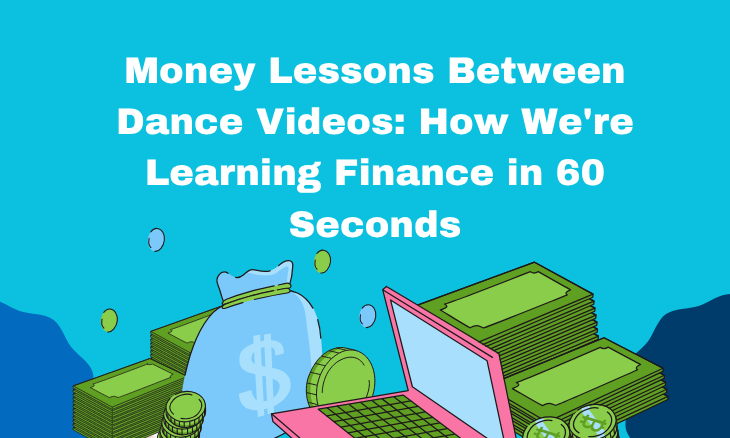It’s 1 AM. I’m scrolling Instagram, half-asleep. A cooking reel. A meme. Then suddenly a 60-second video explaining compound interest that actually makes sense. I save it. Two days later, I open my first investment account.
This is how we learn about money now. Not in classrooms. But between cat videos and dance challenges.
And honestly? It’s working better than anything school taught us.
Let’s Talk About the Elephant in the Room
Most of us in Gen Z have no clue about money. Like, actually no clue.
I’m not talking about advanced strategies. I’m talking basics budgeting, credit scores, how interest works. Stuff our parents assumed we’d just… know?
The harsh truth from FINRA Foundation: Two-thirds of us can’t answer basic financial questions. We’re scrolling apps all day but can’t figure out where our salary disappears by the 15th.
The consequences are real:
- College fees doubled (Bureau of Labor Statistics)
- Buying a house feels impossible
- Half of us don’t make enough to live the life we want (MoneyFit, 2025)
- Millennials are drowning in education loans
The weird part? We grew up with smartphones. We can debug code, edit videos, build brands on social media. But emergency funds or credit cards? Blank stares.
Why We’re So Bad With Money (And It’s Not Our Fault)
Money doesn’t feel real anymore.
When did you last hold cash? Everything’s UPI, everything’s digital. Money is just numbers moving between apps.
Our parents learned by physically handling it , counting notes, saving coins, watching mom bargain. We? Tap a screen. Transaction done. No connection.
Plus, school taught us calculus but not taxes. Periodic table but not credit scores. They forgot the one subject we’ll use every single day.
The Plot Twist: We Found Our Own Teachers
Since school failed us, we went to social media.
And it’s actually working.
PYMNTS Intelligence says: 4 out of 5 of us get financial advice from Instagram, TikTok, and YouTube. The Federal Reserve Bank found we trust Instagram for money advice more than banks.
A 25-year-old with a ring light explaining compound interest through memes makes more sense than a banker using words like “amortization.”
#MoneyTok has exploded. Instagram Reels about budgeting get millions of views (DemandSage, 2025). We watch 200 billion Reels daily—many teaching us about money.
These “finfluencers” break down scary concepts into bite-sized, entertaining content. They speak our language. They’re in hoodies saying “yo, here’s how I paid off my credit card.”
The catch: Not everyone online knows their stuff. PYMNTS found some of us overspend from social media hype, worse -fall for scams. “Double your money in 30 days” stuff.
Instagram is teaching us finance. But we gotta be smart about who we trust.
How to Actually Get Better With Money
Real talk. Here’s what helps:
- Use Social Media Smart
Follow people with actual credentials. Look for clear explanations, sources, real qualifications.
Red flags: “Get rich quick” promises, expensive courses, “secret” tricks.
- Make It Fun
Apps that gamify saving work because they don’t feel like work (ScienceDirect says 40% better):
- Acorns rounds up purchases and invests
- Greenlight/GoHenry for younger siblings
- Modak pays you to walk
- Start With What Matters
Forget crypto for now. Master these:
✓ Budget – Know where money goes (Mint app)
✓ Emergency fund – Save for when life hits
✓ Build credit early – Need it for loans, apartments
✓ Avoid stupid debt – High interest credit cards
✓ Start investing – Even ₹500/month grows
- Talk About Money Out Loud
Global Financial Literacy Excellence Center found people who discuss money make better decisions.
Normalize it: “I overspent this month” or “Let’s both save ₹10,000 this quarter.”
- The 50/30/20 Rule
- 50% needs (rent, food, bills)
- 30% wants (fun stuff)
- 20% savings/investments
- Credit Cards Aren’t Evil
GWI research: Only 10% of us carry balances. But many avoid cards completely, hurting credit scores.
Smart move: Get card → use for small stuff → pay off monthly → never spend what you don’t have.
Good credit = better rates = saving lakhs on loans.
Do This Right Now (10 Minutes)
- Download budgeting app (Mint/YNAB) – 2 min
- Check credit score (BankBazaar, free) – 2 min
- Set up auto-save ₹500/month – 3 min
- Follow 3 legit financial educators – 2 min
- Unsubscribe from shopping emails – 2 min
Total: 11 minutes. Impact: Your entire financial future.
The Bottom Line
Financial literacy in 2025 looks different. Learning from 60-second videos? Valid. Gamified apps? Smart. Starting with ₹500/month? Better than zero.
Traditional advisors are being replaced by 25-year-olds with ring lights explaining money through memes. And we’re learning faster because of it.
Yes, there’s bad advice. Yes, there are scams. But there’s also unlimited free knowledge that’s actually entertaining.
We’re the first generation learning finance through social media. We’re figuring it out. Making mistakes. Learning publicly.
And we’re gonna be fine.
Your future self -debt-free, saving consistently, sleeping peacefully-will thank you for starting today.
The 60-second journey starts now.
Sources
FINRA Foundation (2024) | Bureau of Labor Statistics | MoneyFit (2025) | LIMRA (2024) | PYMNTS Intelligence (2024) | Federal Reserve Bank of St. Louis (2025) | CFA Institute | DemandSage (2025) | Mastercard (2025) | ScienceDirect (2024) | GWI (2025) | Global Financial Literacy Excellence Center (2023)
Full links: finrafoundation.org | bls.gov | moneyfit.org | pymnts.com | stlouisfed.org | cfainstitute.org | mastercard.com | sciencedirect.com
Start today. Your future self is counting on you.

